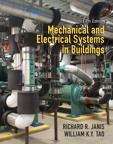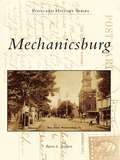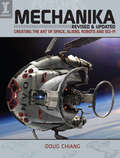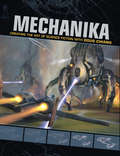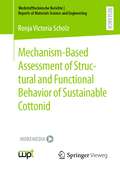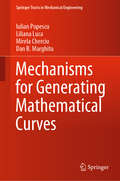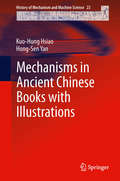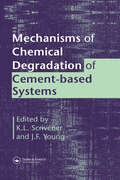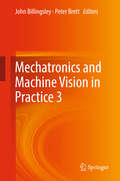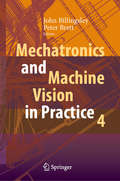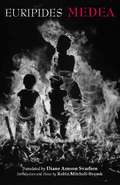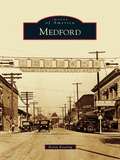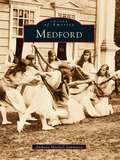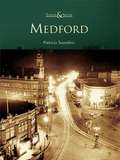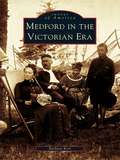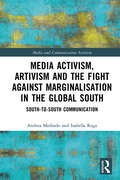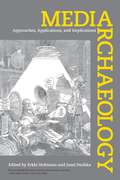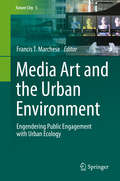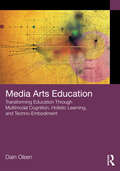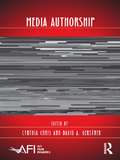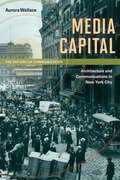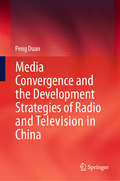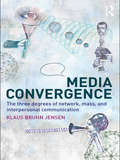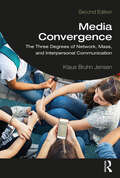- Table View
- List View
Mechanical and Electrical Systems in Buildings
by Richard R. Janis William K. Y. TaoThis extensively updated text and reference illuminates the modern realities of planning and constructing buildings with efficient, sustainable mechanical and electrical systems. Throughout, the authors place mechanical and electrical systems design in the overall context of the built environment. They extensively address engineers' teamwork with architects, owners, and facility managers to provide high-quality, productive environments which reflect both environmental and cost concerns. Focusing on the "what," "why," and "how" of ME systems, they incorporate new developments in all major disciplines, including electrical, lighting, telecom, plumbing and HVAC. New coverage in this edition includes: HVAC design using VRF and chilled beam technologies; energy reclaim systems; dedicated outside air systems; assessment of solar thermal system efficiency; new fuel cell technology; updates on the economics of cogeneration, and much more.
Mechanicsburg
by Byron L. ReppertMechanicsburg, nestled in Cumberland County midway between Harrisburg, the state capital, and Carlisle, the county seat, was once known as Drytown, Pinchgut, and Stauffertown. Incorporated in 1828 and named for a settlement of mechanics that repaired Conestoga wagons, Mechanicsburg was raided by the Confederates and held for three days during the Civil War. Both the Cumberland Valley Railroad and the development of the inland Naval Support Activity Base influenced the rapid growth of this borough. Since 1924, Mechanicsburg has played host to Jubilee Day, Pennsylvania's largest one-day street fair.
Mechanika, Revised and Updated: Creating the Art of Space, Aliens, Robots and Sci-Fi
by Doug ChiangYou can design the future!In a post-apocalyptic alien landscape, starfighters crash land in desert terrain, dino riders rear up, rusted crab walkers litter the horizon and men work with--or fight against--giant iron robots. You control it all and Academy Award-winning sci-fi film production designer Doug Chiang tells you how. In this revised and updated version of his best-selling book, Mechanika, Chiang uses his 25 years in the film industry working on such films as the Star Wars franchise, Terminator 2: Judgment Day and War of the Worlds to teach you the techniques, tools and tips to draw and think like a master sci-fi artist.Inside you'll find:The six keys to good design and how to build an expert toolkit.Basic sketching techniques and the rules of perspective--even in imaginary worlds.25+ step-by-step demonstrations showing how to draw everything from monopods and labor beasts to aliens and steam-powered robots by mixing traditional drawing and marker techniques with digital painting technology.How to create compelling science fiction scenes inspired by movies, books, comics and games from conceptualization to completion.Tips and details on how to use Adobe Photoshop to design, draw and enhance your creations--including author secrets!Learn design secrets from one of the sci-fi artists behind Star Wars, War of the Worlds and Terminator 2: Judgment Day!
Mechanika: Creating the Art of Science Fiction with Doug Chiang
by Doug ChiangDelve into a world of imagination populated with giant robots, strange vehicles, alien creatures and other fantastic inventions. For generations artists have created imagery destined for the entertainment of others, and now you can too.Revered science fiction artist and film designer, Doug Chiang, reveals the thought processes and techniques he used working on blockbusters such as the Star Wars prequels, War of the Worlds, Terminator, and Beowulf. You'll learn from Chiang's visionary experience as he shares his design processes, giving expert advice and showcasing the groundbreaking style that has earned his creations a spot in the Brooklyn Museum, Houston Museum of Fine Art and the Tokyo National Museum.Inside you'll discover:30+ lessons for creating out-of-this-world science fiction scenes in the style featured in films, books, comics, toys and games using both traditional and digital techniquesDetails and tips for using Adobe Photoshop to conceive, design, draw and enhance your creations25 step-by-step demonstrations of outrageous robots, vehicles, creatures and environments with finished color imagesForeword by film producer/director Robert Zemeckis (Monster House, The Polar Express, Back to the Future, Beowulf)With tips on everything from basic skills like blueline sketching and assembling a toolkit to conceptualization and painting for digital art, Mechanika has everything you need to get great results and make your science fiction worlds come alive!
Mechanism-Based Assessment of Structural and Functional Behavior of Sustainable Cottonid (Werkstofftechnische Berichte │ Reports of Materials Science and Engineering)
by Ronja Victoria ScholzRonja Victoria Scholz assesses the performance of cellulose-based Cottonid for implementation as sustainable construction material. Quasi-static and fatigue tests are performed in varying hygrothermal test conditions using mechanical testing systems in combination with integrable climate chambers. To investigate humidity-driven actuation properties, customized specimen holders are designed. Accompanying microstructural in situ experiments in analytical devices enable a profound understanding of effective material-specific damage and failure mechanisms. The findings are transferred into strength-deformation diagrams as well as Woehler curves, which enable a comparative evaluation of several process-related and environmental influencing factors and can directly be used for dimensioning of Cottonid elements for structural applications. The interpretation of thermoelastic material reponse during loading is used as scientific value for lifetime prediction. Comprehensive investigations on industrial standard materials as well as structurally optimized Cottonid variants provide a scientific basis for categorizing material’s structural and functional performance towards common technical plastics and wood.
Mechanisms for Generating Mathematical Curves (Springer Tracts in Mechanical Engineering)
by Dan B. Marghitu Iulian Popescu Liliana Luca Mirela CherciuThis book focuses on important mathematical considerations in describing the synthesis of original mechanisms for generating curves. The synthesis is manual and not based on the use of computer tools. Kinematics is applied to confirm the drawing of the curves, and the closed loop method, and in some cases the distances method, is applied in this phase. The book provides all the notions of structure and kinematics that are necessary to calculate the mechanisms and also analyzes other kinematic possibilities of the created mechanisms. Offering a concise, yet self-contained guide to the mathematical fundamentals for mechanisms of curve generation, together with a useful collection of mechanisms exercises, the book is intended for students learning about mechanism kinematics, as well as engineers dealing with mechanism design and analysis. It is based on the authors’ many years of research, which has been published in different books and journals, mainly, but not exclusively, in Romanian.
Mechanisms in Ancient Chinese Books with Illustrations
by Hong-Sen Yan Kuo-Hung HsiaoThis book presents a unique approach for studying mechanisms and machines with drawings that were depicted unclearly in ancient Chinese books. The historical, cultural and technical backgrounds of the mechanisms are explained, and various mechanisms described and illustrated in ancient books are introduced. By utilizing the idea for the conceptual design of modern mechanisms, all feasible designs of ancient mechanisms with uncertain members and joints that meet the technical standards of the subjects' time periods are synthesized systematically. Ancient Chinese crossbows (the original crossbow and repeating crossbows), textile mechanisms (silk-reeling mechanism, spinning mechanisms, and looms), and many other artisan's tool mechanisms are used as illustrated examples. Such an approach provides a logical method for the reconstruction designs of ancient mechanisms with uncertain structures. It also provides an innovative direction for researchers to further identify the original structures of mechanisms and machines with drawings in ancient literature. This book can be used as a textbook and/or supplemental reading material for courses related to history of ancient (Chinese) machinery and creative mechanism design for senior and graduate students.
Mechanisms of Chemical Degradation of Cement-based Systems
by K. L. Scrivener J. F. YoungDeterioration of cement-based materials is a continuing problem, as it results in the substantial shortening of the lives of conventional concrete structures. The main costs result from poor performance and the need for early repair. With more advanced applications, where very long service lives are essential, such as the storage of nuclear waste,
Mechatronics and Machine Vision in Practice 3
by John Billingsley Peter BrettIn contrast with previous books on mechatronics and machine vision in practice, a significant number of chapters focus on systems designed for human interaction and deciphering human motion. Examples illustrate assistive actuation of hip joints, the augmentation of touch sense in artificial hand prostheses and helping stroke survivors in repetitive motion therapy. Interactive mechatronics and the experience of developing machine interfaces has enabled an examination of how we use mechatronics in the service of training, and even to consider why computer games perhaps appear to capture attention so much more readily than a human instructor! Mechatronics continues to be an exciting and developing field. It is now an essential part of our world and living experience. This and the previous books in this series illustrate the journey in developing the use of mechatronics so far. We anticipate that you will find the chapters here an equal source of inspiration for new devices to solve the challenges of new applications, and of course as a resource for teaching and inspiring the new generation of mechatronics engineers.
Mechatronics and Machine Vision in Practice 4 (Robotics And Mechatronics Ser. #Vol. 4)
by John Billingsley Peter BrettThe many intriguing examples on the application of mechatronics reinforce the excitement of this creative field of technology. As a collection they present a stimulating resource to developers of future mechatronics technology, and to educators searching for interesting examples. From structured-light measurement of the build-up of detritus on railway bogies and detection of uncracked spores of Chinese medicine to a practical tractor vision guidance system embedded in a smart-phone application, the practical applications of mechatronics and machine vision abound. Fruits are counted on the tree, pasture biomass is measured and a robot collects camel dung as a resource. 3D printing is in vogue, but papers here discuss the construction and strategy of the printer itself. The measurement and analysis of myoelectric muscle signals enable a prosthesis to be controlled and a feeding robot is used for patient care. An exoskeleton has both soft and rigid links and an optical sensor analyses the tissue into which a surgical needle is being inserted. These are some of the papers in this collection from the 26th annual conference on Mechatronics and Machine Vision in Practice, carefully selected to exclude papers that are merely theoretical and to highlight those that show practical verification. Papers have been contributed from China, New Zealand, the Philippines, Emirates, Germany and of course Australia.
Medea
by Euripides Diane Arnson Svarlien Robin Mitchell-BoyaskThis is the Medea we have been waiting for. It offers clarity without banality, eloquence without pretension, meter without doggerel, accuracy without clumsiness. No English Medea can ever be Euripides', but this is as close as anyone has come so far, and a good deal closer than I thought anyone would ever come. Arnson Svarlien has shown herself exceedingly skillful in making Euripides sound Euripidean.--David M. Schaps, Bryn Mawr Classical Review
Medea
by Euripides Diane Arnson Svarlien Robin Mitchell-BoyaskThis is the Medea we have been waiting for. It offers clarity without banality, eloquence without pretension, meter without doggerel, accuracy without clumsiness. No English Medea can ever be Euripides', but this is as close as anyone has come so far, and a good deal closer than I thought anyone would ever come. Arnson Svarlien has shown herself exceedingly skillful in making Euripides sound Euripidean.--David M. Schaps, Bryn Mawr Classical Review
Medford
by Kevin KeatingIradell Phipps and Conrad Broback saw a golden opportunity in 1884. After convincing the railroad to build its depot on their prairie land near Bear Creek, they began building what became the second-fastest growing city in America, with over 100 new buildings in its first year. Few Medfordites today know that the city once had four separate railroads and was renowned throughout Europe. Intrepid flyers Eugene Ely, Pat Patterson, Seely Hall, and Charles Lindbergh made Medford a regional air hub during the early days of flight. In 1910, Medford had more automobiles per capita than any town in the world, and in 1923, it straddled the world's longest paved road. Told through photographs, facts, and anecdotes, the story of the hometown of film and radio stars Pinto Colvig and Ginger Rogers, as well as sports greats like Dick Fosbury, Bill Bowerman, and Kyle Singler, is a captivating read.
Medford (Images of America)
by Anthony Mitchell SammarcoReferred to in its beginning as a "peculiar town," Medford was originally a town but a plantation owned by Governor Matthew Craddock. Known as Meadford at the time of its settlement in 1630, the area was a flourishing village located along the Mystic River that boasted numerous farms, fisheries, and shipbuilding. A small town for the first two centuries after it was settled, Medford was conveniently located only a few miles from Boston. Its prime location soon attracted thousands of residents, and by the turn of the twentieth century, Medford had become a cultural mecca with over 18,000 residents. The town's strong sense of community and respect for diversity has continued through the years, transforming a small fishing and farming village into one of the finest residential communities in metropolitan Boston. In Medford, author Anthony Mitchell Sammarco invites his readers to join him on a journey back in time to an earlier Medford, when local transportation meant a ride on a horse-drawn streetcar or a train ride on the Boston & Lowell line. Within these pages, learn little-known facts about the founding of renowned institutions such as Tufts University, view candid snapshots of early Medford residents at work and at play, and discover rare photographs of the area's more unusual influences, from the exotic foods and customs introduced by European settlers to the impact of the town's gypsy moth dilemma.
Medford (Then and Now)
by Patricia SaundersMedford, originally referred to as Meadford, was settled as a plantation in 1630 by Gov. Matthew Craddock. A historic city located on the Mystic River in Middlesex County, Medford gained fame from its clipper ships, crackers, and rum. The song "Jingle Bells" was composed here by James Pierpoint in the early 1850s. Many prominent citizens have lived in Medford, including Amelia Earhart, who moved to the city in 1924. Medford, part of the Then & Now series, connects this city's past with its present by comparing historic and modern photographs of sites such as the Royall House, Jonathan Wade House, and Peter Tufts-Craddock House.
Medford in the Victorian Era (Images of America)
by Barbara KerrWhen the Boston and Lowell Railroad came through in 1835, Medford was a quiet town with fewer than two thousand residents. By the twentieth century, it had become a thriving city of eighteen thousand. In Victorian Medford, everything was new, from the Medford Opera House, the town hall, and the Mystic Lakes to the camera, the bicycle, and the gypsy moth. The shipbuilding, rum, and brickmaking industries gave way to new businesses, and traditional houses came to share neighborhoods with Queen Anne and Shingle-style architecture. In the mid-nineteenth century, there was great social change, as abolitionists Lydia Maria Child and George Luther Stearns spoke out against slavery and men went to the Civil War. James W. Tufts invented the soda fountain, Fannie Farmer wrote her first cookbook, and James Pierpont wrote "Jingle Bells."
Media Activism, Artivism and the Fight Against Marginalisation in the Global South: South-to-South Communication (Media and Communication Activism)
by Andrea Medrado Isabella RegaThis book analyses a South-to-South connection between media activists and artivists – artists who are activists – in the Global South. The authors, Andrea Medrado and Isabella Rega, emphasise the urgent need to engage in South-to-South dialogues in order to create more sustainable connections between Global South communities and as an essential step towards identifying and facing global problems, such as state repression, social inequality and climate crises. Medrado and Rega analyse the characteristics of this connection, identify its unique contributions to the study of media and social change and discuss its long-term sustainability. They do so by focusing on instances when media narratives in countries of different Global South(s) intertwine and transform each other; specifically, the exchanges between Latin America (Brazil) and Africa (Kenya). They explore how media activism and artivism can be used as tools for global movement building and to challenge colonial legacies. They also discuss how to connect people with varied skill sets in different Global South contexts, promoting South-to-South solidarity, in a cross-continental challenge to marginalisation. Crucial reading for students and scholars of media activism, social movements, global media and communication, development studies and international studies, as well as activists and social movement organisations.
Media Archaeology: Approaches, Applications, and Implications
by Erkki Huhtamo Jussi ParikkaThis book introduces an archaeological approach to the study of media - one that sifts through the evidence to learn how media were written about, used, designed, preserved, and sometimes discarded. Edited by Erkki Huhtamo and Jussi Parikka, with contributions from internationally prominent scholars from Europe, North America, and Japan, the essays help us understand how the media that predate today’s interactive, digital forms were in their time contested, adopted and embedded in the everyday. Providing a broad overview of the many historical and theoretical facets of Media Archaeology as an emerging field, the book encourages discussion by presenting a full range of different voices. By revisiting ‘old’ or even ‘dead’ media, it provides a richer horizon for understanding ‘new’ media in their complex and often contradictory roles in contemporary society and culture.
Media Art and the Urban Environment
by Francis T. MarcheseThis text formally appraises the innovative ways new media artists engage urban ecology. Highlighting the role of artists as agents of technological change, the work reviews new modes of seeing, representing and connecting within the urban setting. The book describes how technology can be exploited in order to create artworks that transcend the technology's original purpose, thus expanding the language of environmental engagement whilst also demonstrating a clear understanding of the societal issues and values being addressed. Features: assesses how data from smart cities may be used to create artworks that can recast residents' understanding of urban space; examines transformations of urban space through the reimagining of urban information; discusses the engagement of urban residents with street art, including collaborative community art projects and public digital media installations; presents perspectives from a diverse range of practicing artists, architects, urban planners and critical theorists.
Media Arts Education: Transforming Education Through Multimodal Cognition, Holistic Learning, and Techno-Embodiment
by Dain OlsenThis book introduces and explains the emergent and dynamic discipline of media arts education and its potentials for educational transformation. Through an examination of its theoretical principles, holistic pedagogy, adaptive instructional practices, and diverse creative capacities, it demonstrates how media arts education can lead to a more student-centered, interdisciplinary, and effective educational model.Chapters combine academic research and practical examples to give an in-depth understanding of media arts education as it exists within schools today, as well as its potential for educational advancement. Author Dain Olsen provides an instructional framework for the discipline, including its history, research from cognitive and learning science, pedagogical principles, and examples of instructional practice. The book discusses how media arts education promotes active, multimodal and inquiry-based learning, constructivist methodology, and transdisciplinary integrations. Media arts affords students the ability to construct and simulate anything imaginable, supporting their self-directed creative inquiry. Not only can they create the myriad of artistic media, they can use it in representing and applying any core content so that it becomes aesthetically interactive, malleable and understandable. Later chapters include examples of media arts educator practices with lesson descriptions, project sequences, and instructional narratives. The book argues that media arts education can form a multimodal, interconnective, and adaptive educational system that is more empowering, engaging, flexible, and equitable for all students’ academic success.This resource is an essential companion for media arts educators at all levels. As it covers integration across a variety of contexts, it will additionally benefit educators in the fields of visual and performing arts, career technical education, media studies, computer science, and STEM and STEAM education.
Media Authorship (AFI Film Readers)
by David A. Gerstner Cynthia ChrisContemporary media authorship is frequently collaborative, participatory, non-site specific, or quite simply goes unrecognized. In this volume, media and film scholars explore the theoretical debates around authorship, intention, and identity within the rapidly transforming and globalized culture industry of new media. Defining media broadly, across a range of creative artifacts and production cultures—from visual arts to videogames, from textiles to television—contributors consider authoring practices of artists, designers, do-it-yourselfers, media professionals, scholars, and others. Specifically, they ask: What constitutes "media" and "authorship" in a technologically converged, globally conglomerated, multiplatform environment for the production and distribution of content? What can we learn from cinematic and literary models of authorship—and critiques of those models—with regard to authorship not only in television and recorded music, but also interactive media such as videogames and the Internet? How do we conceive of authorship through practices in which users generate content collaboratively or via appropriation? What institutional prerogatives and legal debates around intellectual property rights, fair use, and copyright bear on concepts of authorship in "new media"? By addressing these issues, Media Authorship demonstrates that the concept of authorship as formulated in literary and film studies is reinvigorated, contested, remade—even, reauthored—by new practices in the digital media environment.
Media Capital: Architecture and Communications in New York City (The History of Communication)
by Aurora WallaceIn a declaration of the ascendance of the American media industry, nineteenth-century press barons in New York City helped to invent the skyscraper, a quintessentially American icon of progress and aspiration. Early newspaper buildings in the country's media capital were designed to communicate both commercial and civic ideals, provide public space and prescribe discourse, and speak to class and mass in equal measure. This book illustrates how the media have continued to use the city as a space in which to inscribe and assert their power. With a unique focus on corporate headquarters as embodiments of the values of the press and as signposts for understanding media culture, Media Capital demonstrates the mutually supporting relationship between the media and urban space. Aurora Wallace considers how architecture contributed to the power of the press, the nature of the reading public, the commercialization of media, and corporate branding in the media industry. Tracing the rise and concentration of the media industry in New York City from the mid-nineteenth century to the present, Wallace analyzes physical and discursive space, as well as labor, technology, and aesthetics, to understand the entwined development of the mass media and late capitalism.
Media Convergence and the Development Strategies of Radio and Television in China
by Peng DuanThis book discusses the development strategies of Chinese media convergence in the current, fast-changing communication environment. Drawing on both theoretical and empirical data and based on the author’s observations, focus groups, and in-depth analyses of selected Chinese radio and TV networks, it illustrates key lessons for the maintenance and future improvement of talents, advertisement, media organization management, business development, and coping strategies. Further, it outlines a framework that helps readers to consider how to use communication strategies for the construction of media convergence in the context of China by referring to theories of international communication and political communication.Presenting research on the development strategies of Chinese media convergence, it offers a systematic study of the processes through which the Chinese radio and television industries make use of proper communication strategies to have a profound global influence.
Media Convergence: The Three Degrees of Network, Mass and Interpersonal Communication
by Klaus Bruhn JensenThe development of digital media presents a unique opportunity to reconsider what communication is, and what individuals, groups, and societies might hope to accomplish through new as well as old media. At a time when digital media still provoke both utopian and dystopian views of their likely consequences, Klaus Bruhn Jensen places these ‘new’ media in a comparative perspective together with ‘old’ mass media and face-to-face communication, restating the two classic questions of media studies: what do media do to people, and what do people do with media? Media Convergence makes a distinction between three general types of media: the human body enabling communication in the flesh; the technically reproduced means of mass communication; and the digital technologies facilitating interaction one-to-one, one-to-many, as well as many-to-many. Features include: case studies, including mobile phones in everyday life, the Muhammad cartoons controversy and climate change as a global challenge for human communication and political action diagrams, figures, and tables summarizing key concepts beyond standard ‘models of communication’ systematic cross-referencing. Major terms are highlighted and cross-referenced throughout, with key concepts defined in margin notes.
Media Convergence: The Three Degrees of Network, Mass, and Interpersonal Communication
by Klaus Bruhn JensenThis second edition furthers conversations about the ongoing society-wide and worldwide digitalization of human communication. Reviewing the long lines in the history of media and communication – from writing via printing and broadcasting to computing – the book lays out three general types of media: the human body enabling face-to-face communication here and now; the technically reproduced means of mass communication across space and time; and the digital technologies integrating one-to-one, one-to-many, as well as many-to-many interactions. All these communicative practices coexist in contemporary media environments. Across cultures, genders, and age groups, people go on communicating in the flesh, via wires, and over the air, as illustrated though case studies of mobile communication on mundane matters, and of climate change as a global challenge for human communication and coexistence. The second edition includes: Updated accounts of research and public debate on digital media and communication Analyses of current social media and an emerging internet of things Systematic presentations of digital as well as traditional empirical methods Discussion of the normative implications of digitalization, including the classic rights of information and communication, and a right not to be communicated about through surveillance Interdisciplinary in scope to showcase the wide-reaching cultural consequences of media convergence, this book is ideal for advanced undergraduate students, graduate students, and scholars in the fields of media, communication, and cultural studies.
